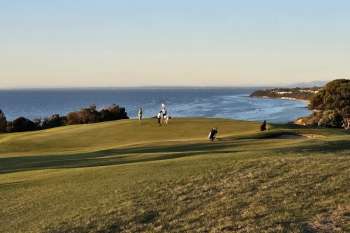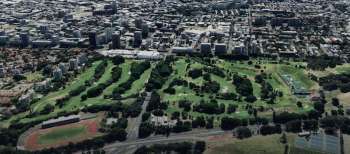It all began with an innocent conversation about ranking great golf holes, and whether it was possible, or even fair, to compare an outstanding par three with a similarly outstanding par four or five. In Australia there are dozens of examples of each. There are also many ways to measure greatness, and we have always felt that superb golf should be celebrated regardless of its style, its location or its par.
Wanting to celebrate our finest golf holes without simply ranking them, we decided to create the Australian Golf Digest Hall of Fame, established to honour the best and most iconic par threes, fours and fives in the country.
Great golf holes are the bedrock of great golf courses, but there are also places around Australia where a single brilliant hole can elevate the entire golfing experience and make an ordinary course a must-play destination. The most obvious examples include the 3rd hole at the Tasmania Golf Club and the 3rd at Narooma, one of five short holes inducted into the Hall of Fame this year. Whether Hogan’s Hole at Narooma is a better par three than the 15th at Kingston Heath or the 11th at Yarra Yarra is debateable, but clearly each is an important member of the Australian golf community and worthy of inclusion amongst such an esteemed group.
In this, our inaugural year, we decided to induct 18 holes into the Hall of Fame, and our rules dictated that we would only allow one hole, per course, per induction – so expect further holes in coming years from the likes of Kingston Heath, Royal Melbourne and Barnbougle Dunes. We also decided that holes had to have been in play for at least 12 months in order to be eligible for the Hall of Fame, which is a similar standard we apply to our top 100 course ranking list. This means somewhere like Lost Farm in Tasmania, with several obvious candidates, could not be considered for the class of 2011. Expect it to feature in 2013.
Given these parameters and the fact that we wanted to induct our best and most iconic holes first, there is a natural bias in this initial class toward older holes over more modern ones. This is understandable given classic courses dominate the first third of our Top 100 list. There are, however, some obvious exceptions, such as the breathtaking 7th hole on the Old Course at The National and the gloriously original 4th at Barnbougle Dunes, which is only a few years old but already an international legend.
For different reasons we also inducted celebrity closing holes at Palm Meadows and Hyatt Coolum, as much for their tournament prominence as the excellence of their design. Both are exciting water holes that have played a major role in determined the outcome of professional championships. The 18th at Coolum has become one of the most identifiable holes in the nation over the past decade, and the resort’s reputation as a tournament test continues to rise. By contrast, Palm Meadows has become somewhat of the forgotten star of Australian golf and the course has actually stood on the brink of closure for much of the past year. It still has an uncertain future but what can’t be denied is its past, and the role Palm Meadows played during golf’s heady days of the 1980s and early 90s. Its 18th hole deserves a place within our Hall of the Fame, and we wanted to honour the hole this year in case it wasn’t in play next time around.
Like any sporting Hall of Fame, the criteria used by our panel to select the inducted holes is unlikely to please all readers and golf operators, and we expect as much debate and conjecture about this list as our Top 100 course rankings. In our defence, we ask critics to look not at what was overlooked, but instead to focus on the quality of what has been included here in this inaugural class. These holes are superb examples of the best of Australian golf, and they represent the great variety and diversity available across our wonderful industry. Those lucky enough to have played all 18 have been truly blessed.
Australian Golf Digest Hall of Fame – 2011 inductees
15th Hole at Kingston Heath Golf Club - 142m Par Three
The developer of America’s hugely successful Bandon Dunes Resort recently nominated the 15th at Kingston Heath as the finest uphill par three in all of golf. It is hard to argue with his selection, for the bunkering and green contouring here are quite extraordinary and showcase the artistic genius of creator Dr. Alister MacKenzie. Like Victoria, Royal Sydney and The Australian, Kingston Heath was already built when MacKenzie arrived to offer design suggestions in 1926. Impressed by what he saw at The Heath, he nominated just one structural alteration – replacing a blind par four with this short uphill work of art. Rare is the golfer who stands on this tee without feeling a tinge of excitement as they prepare to play what is unquestionably the most testing short-iron shot in the country. Its inclusion in our Hall of Fame was a massive no-brainer.
7th Hole at The National Golf Club (Old Course) – 139m Par Three
When the initial routing for the first (Old) course at The National Golf Club was completed, the current 7th hole actually headed in the opposite direction. For those familiar with the hole, that meant you essentially stood on what is now the green and played across the giant ravine to what is now the tee box – in other words, away from the sublime views of Bass Strait and the Mornington Peninsula. Fortunately for the club, when Robert Trent Jones II’s design team had cleared the necessary ti-tree from the site they sensibly reversed the direction this gem was to be played. Whilst it may sound a stretch, this decision helped secure the future of The National, as much of the hype surrounding the club during its formative years was due to images of this hole, and the reports from those who had played it. The National is now a major success story and Australia’s largest golfing facility. Those who haven’t yet had the pleasure of tackling this glorious hole should definitely add it to their ‘bucket list’.
11th Hole at Yarra Yarra Golf Club – 165m Par Three
Of all the short holes in Australia, perhaps only the 15th at Kingston Heath features a more elaborately contoured green complex than Alex Russell’s 11th hole at Yarra Yarra. This treacherous par three is famous for its triple-tiered putting surface, which is slightly elevated, angled awkwardly across the tee, shallow and protected by punishing bunkers. Higher right side pins are notoriously intimidating, but lower flags are also difficult as the only safe place to leave your ball here is under the hole. Finding one of the enormous frontal bunkers is a recipe for bogey, while missing long can be even worse as you invariably face a delicate sand blast to a sharply angled green falling away toward the aforementioned traps.
What’s particularly impressive about Yarra’s 11th hole is that its setting is not overly attractive, given the dead ground between tee and green and the fact that neighbouring homes are visible in the background. The target area itself, however, is a masterpiece of design, and something that all golfing Melbournians are justifiably proud.
3rd Hole at Narooma Golf Club – 141m Par Three
While true that the greatest golf courses generally have the best holes, the 3rd at Narooma Golf Club on the NSW South Coast is proof that even the most unassuming layout can leave a golfer completely breathless. This remarkable par three, played directly across the Pacific Ocean, is known as Hogan’s Hole for it once featured in a popular Paul Hogan television commercial promoting Australia. Unlike the previously listed par threes, with their sophisticated green shapes, the 3rd at Narooma features a rather bland putting surface that leans gently to the front and is guarded by a fairly uninspired bunker. What makes this iconic par three so memorable is the area between tee and green, a spectacular Pacific Ocean blow-out.
13th Hole at Barwon Heads Golf Club – 130m Par Three
The shortest and simplest par three inducted into our Hall of Fame, is the 13th at Barwon Heads, which is also the only bunkerless hole among the class of 2011. Set atop a gentle sand ridge, the tee shot here can be anything from a flick wedge to a piercing long iron depending on the wind. The target is notoriously difficult to hit, with the putting surface miniscule and surrounded by subtle bumps and ground undulations. Like the Postage Stamp at Royal Troon, the genius of the 13th at Barwon Heads is that a pure shot invariably finds the green, while even a slight miss will kick off the edge and bound away into a dangerous area. This hole is one of the greatest advertisements in Australia for short grass as a legitimate greenside hazard.
Beyond its pure golfing charms, the fact that the town’s popular surfing beach was named in honour of the 13th at Barwon Heads is a further tribute to the quality of this ageless devil.
4th Hole at Barnbougle Dunes Golf Links – 271m Par Four
Take a look at any decent picture of this hole, or talk to those who have played at Barnbougle Dunes, and it becomes immediately apparent why the 4th here has been fast-tracked into our Hall of Fame. With its magnificent sand hill setting, stunning bunkering, quirky punchbowl green site and multiple routes of attack, the 4th at Barnbougle has everything a great gambling hole needs. Indeed, there may not be a more enjoyable par four to play in the country.
4th Hole at Woodlands Golf Club – 251m Par Four
One of the simplest great par fours in golf, the 4th at Woodlands is easily reachable from the tee but it features a truly sinister green that is steeply perched and only a couple of paces wide at the front. For every player standing on this tee the equation is simple; do whatever you can to keep your ball square to the front section of the green and you’ll have no dramas. The trick of course, is that the longer you hit your drive the more difficult it becomes to keep it on that narrow axis, but the simpler the birdie or eagle becomes if you do keep it straight. Ask any long-standing member of Woodlands if a 250-metre par four can be difficult, and they will reel off names of top quality players who have racked up big numbers on this subtle wonder. As some of our leading professionals can attest, miss the 4th green at Woodlands pin high on either side and you will not only struggle to make par, you‘ll probably struggle to make a bogey.
3rd Hole at Royal Adelaide Golf Club – 266m Par Four
Even those who dislike blind holes would struggle to counter an argument that the 3rd at Royal Adelaide is among the most outstanding short par fours anywhere in the world. Interestingly, it’s also the only hole at Seaton that remains structurally faithful to the design suggested by Dr. Alister MacKenzie when he visited the club in 1926. Played beyond a small crest and along a sizeable sand ridge, the brilliance of this piece of design is that the more aggressive the tee shot, the riskier it becomes, but also the simpler the birdie for those who strike their tee ball accurately. The green is narrow at the front and squeezed between the dune and a small knoll, which works perfectly to complicate any pitch shot played from the fat side of the fairway. Eagles and birdies are common here, but so are big numbers. Norman von Nida once took a 9 on this hole while Colin Montgomerie carded an 8.
11th Hole at The National Golf Club (Moonah Course) – 359m Par Four
The most common criticism of the Moonah Course at the National Golf Club is that once you putt out on the 11th, you face a long stretch of holes played into the stiff prevailing winds. The blame for this can be laid squarely at the foot of the 11th hole itself, which is on such glorious dune land that lead course architect Bob Harrison felt he simply had to incorporate it into his layout. Getting into the area meant accepting a slightly disjointed routing, but the trade-off was a superb mid-length par four played first through a natural saddle and then across a bunkered ridge into an angled bowl-shaped green. There are a number of outstanding holes on the Moonah Course, but the 11th tells the best tale and is the one that first-time visitors are most likely to remember.
5th Hole at Newcastle Golf Club – 368m Par Four
The premier hole on one of regional Australia’s premier golf courses, the 5th at Newcastle is a dramatic par four that tumbles through and across a series of gentle dune ridges. Newcastle was designed by Eric Apperly, who was mentored in golf architecture by Dr. Alister MacKenzie whilst working with him on the New South Wales Golf Club project. The green and bunker shaping here lacks the sophistication of MacKenzie’s great courses on Melbourne’s Sandbelt, but there are few more exciting par fours anywhere than Newcastle’s 5th. Downwind you can hit this green with a wedge, but your tee shot needs to be hit with precision and shaped from right to left in order to avoid the dense off-fairway vegetation. Into the wind, driving to the top of the fairway is an achievement and can still leave you with a dangerous mid-to-long iron approach shot.
18th Hole at Hyatt Regency Coolum – 385m Par Four
Whether the 18th hole on the Hyatt Regency Coolum course is a great hole or not depends on your definition of great golf. It’s certainly a strategic test, that rewards brave drives with simpler approach shots, but it’s uncomfortably tight and one could argue that the putting contours are a little contrived. What makes this hole so significant to the local golf industry is the role it has played over the past nine years in determining the winner of the time-honoured Australian PGA Championship. We’ve seen plenty of primetime drama here, including playoffs abandoned because of light, champions crowned after holing outrageous bunker shots and wannabe champions having their hopes dashed by approach shots that end up in water. There was also last December’s unforgettable Monday finale where veteran Aussie golfer Peter Senior defeated the much younger Geoff Ogilvy in extra-time. By any measure the PGA at Coolum has been a raging success, and it has helped make a celebrity of both the Hyatt Coolum course as well as its infamous 18th hole.
18th Hole at Royal Melbourne Golf Club (East Course) – 395m Par Four
Once the most famous finishing hole in Australian golf, the 18th on the East Course at Royal Melbourne is also the closing hole on the club’s much-revered Composite Course. It’s a course that has hosted its share of prominent events, from the Eisenhower Trophy in 1968 to the World Cup in 1972 and 1988, the Bicentennial Classic, the President’s Cup, the Heineken Classic and numerous Australian Opens. This wonderfully designed par four has seen its share of heroics over the years, including Wayne Riley’s incredible 40-foot bomb to win the 1991 Australian Open and Craig Parry’s chip-in to beat Tiger Woods and Fred Couples during the 1998 President’s Cup. There was also Billy Dunk’s equally remarkable up and down from the shaggy island inside the right greenside bunker, which is now named in his honour. As 18 East at Royal Melbourne can’t be stretched any further, it doesn’t quite hold the same demons as years past for the professionals, but for most amateur golfers it remains a suitably stern close to the round.
6th Hole at Royal Melbourne Golf Club (West Course) – 391m Par Four
There was a time when 6 West at Royal Melbourne was arguably the finest par four in the southern hemisphere, a perfectly proportioned and angled dogleg hole with a leaning fairway and a remarkable green site cut into a base of a scrubby dune. Those who were able to hug the dangerous right side from the tee were given a much more manageable angle into this treacherous target.
The problem with the modern hole is that bigger hitters can now more easily carry the right side bunkers, so the risk from the tee has been diminished and the approach shot is generally played with a more lofted iron. The club also needs to clean out some of the scrub between tee and bunkers, to expose more of the sand and restore the integrity of the original design concept.
Regardless of its present form, this magnificent Dr. MacKenzie hole remains the most strategic par four we have in this country, and for most amateurs is one of the most satisfying to par. The green site remains unchanged, and is a genuine masterpiece in every sense. Here the target is elevated and defended by a fierce false front and a putting surface that slopes severely from back to front. Attempting to leave your ball under the hole here is dangerous, but absolutely essential if you hope to avoid a three putt.
12th Hole at The Cut Golf Course – 400m Par Four
Designed by Jim Wilcher, The Cut Golf Course opened in 2005 and immediately made headlines due to its proximity to some of the wildest and most dramatic coastal sand structures in Western Australia. Though the course has serious flaws and has suffered serious hardships in its short life, including a change of ownership, what remains absolutely true about The Cut is that few visitors will ever forget the experience of playing the signature 12th hole. This strong par four runs directly alongside the ocean, tumbling through some sizeable dunes before turning right and rising sharply into an undulating green squeezed between formal bunkers and an unkempt waste.
Some will question whether a hole like the 12th is worthy of its place in our Hall of Fame, but ask West Australian golfers to nominate the standout hole in their state and our guess is that more will select this one than any other.
5th Hole at New South Wales Golf Club – 468m Par Five
Not sure there is a more exhilarating feeling in golf than traversing the crest of the 5th fairway at the New South Wales Golf Club and staring down toward the crashing waves of La Perouse. Whether you have smashed your drive down the middle of the fairway or are walking toward your second shot, the view and the sensation of playing to a green pushed back against the sea is unique in Australian golf. Those who tell you this is a flawed masterpiece overlook the fact that on a windy, coastal site it offers precisely the sort of challenge all exposed links hole should aim to provide. True it can be a doddle downwind and an absolute torture test into a stiff breeze, but regardless of conditions it is playable to all and forgiving only to those who can strike their drives with strength and accuracy. This hole is truly an Australian icon, and arguably the most breathtaking par five in the world.
18th Hole at Palm Meadows Golf Course – 523m Par Five
One of the trailblazers of Gold Coast resort golf, Palm Meadows was designed by Graham Marsh and Ross Watson, and opened to considerable fanfare during the mid-1980s. It first made headlines by hosting the rich Daikyo Palm Meadows Cup, which not only put the resort on the golfing map, but also made a star out of its heroic par five finishing hole. Doglegging right around a massive lake that needs to be crossed twice en-route to the green, what made this hole such a success in its early days was the fact that it did what every gambling closing par five should do, and that is influence the outcome of major championships. The hole works strategically because the fairway out to the left allows golfers to either play the hole conservatively or attack the lake in order to reach the green in two. Greg Norman, who was once the touring professional here, won the first Palm Meadows Cup in 1988 on the back of some incredibly aggressive driving on this hole. Even more memorable was the 1990 event, when local favourite Rodger Davis eagled the 18th to edge out defending champion Curtis Strange, who had taken the safer three-shot option instead.
Though the halcyon days for Palm Meadows have long passed, the 18th hole still provides visitors with a wonderful close to their round and a reminder of the glory period for the Australian PGA Tour. After closing midway through last year, Palm Meadows reopened in December under new management. We wish the current operators well, as it would be a great shame if Aussie golfers were no longer able to experience this exciting Hall of Famer.
3rd Hole at Tasmania Golf Club – 528m Par Five
The Tasmania Golf Club was established when the relocating Lindisfarne Golf Club moved from its original home to a new site beside Hobart’s picturesque Barilla Bluff. Here the members golfed on an Al Howard designed course that opened in 1971 and was instantly famed for its spectacular par five 3rd hole. Measuring more than 520m and following the natural curve of the bay, the shape and strategy of this hole mimics the famous 18th at Pebble Beach, except that here the box tee is elevated providing players with a wonderful view of the coastline. Those able to bite off more of the bay with their drive are left with a shorter approach toward a green that is sensibly angled to be easier to hit from close to the water.
Aside from hosting significant events like the Australian Amateur and the Tasmanian Open, the Tasmania Golf Club has also been the home for many of the states finest players including Mathew Goggin and his mother Lindy.
11th Hole at The Lakes Golf Club – 528m Par Five
Bending around the main watercourse at The Lakes Golf Club in Sydney, the long par five 11th is among the finest, and most recognisable, championship holes in the country. Although The Lakes was redesigned by Michael Clayton a couple of years back, the structure of this hole has remained in place since the original layout was designed by Robert von Hagge in the 1970s. From a lake-side tee golfers hit toward a reasonably generous landing zone, with water waiting to catch any drives that have been slightly pushed or sliced. From here the fairway turns sharply to the right, forcing stronger players to decide whether to carry the lake and hit straight at the peninsula green, or play safe and take the three-shot route instead.




